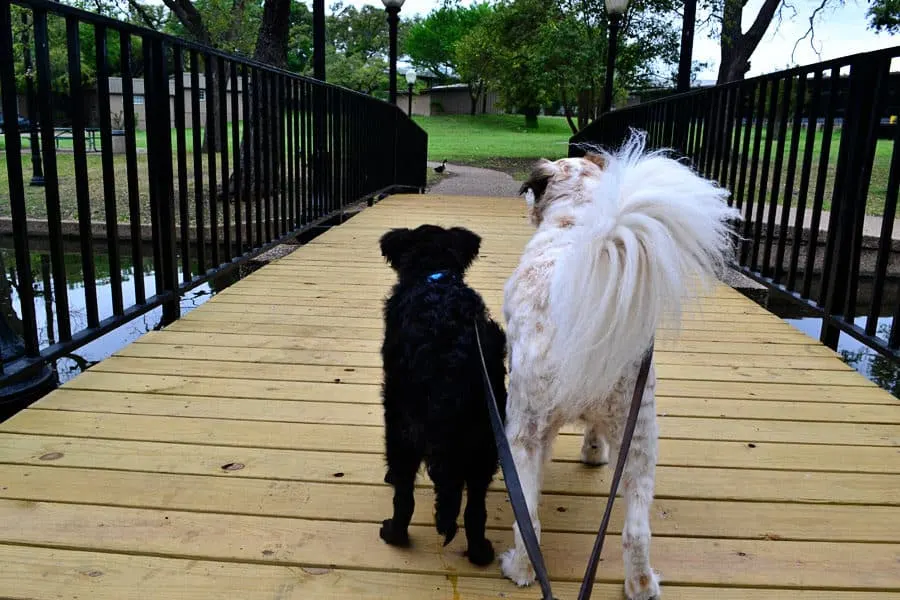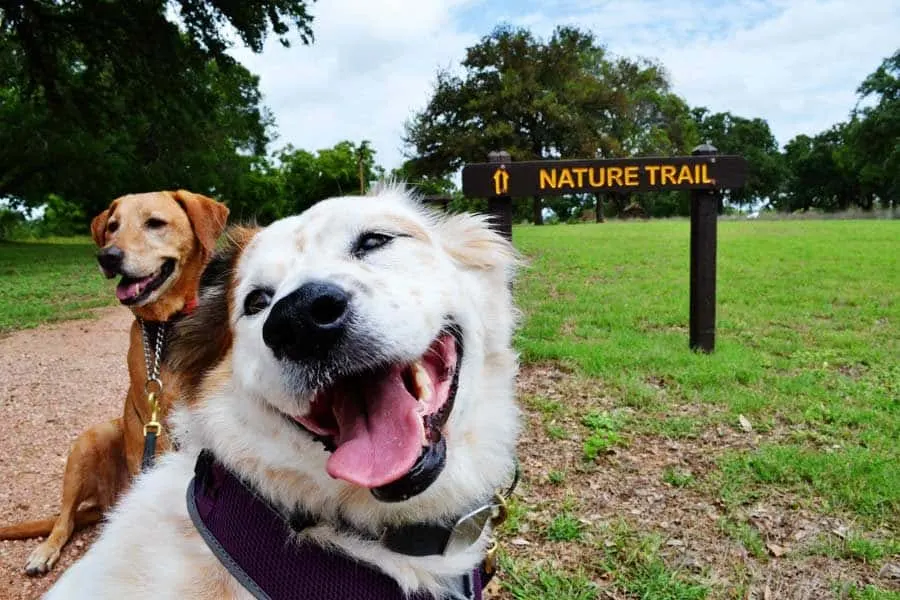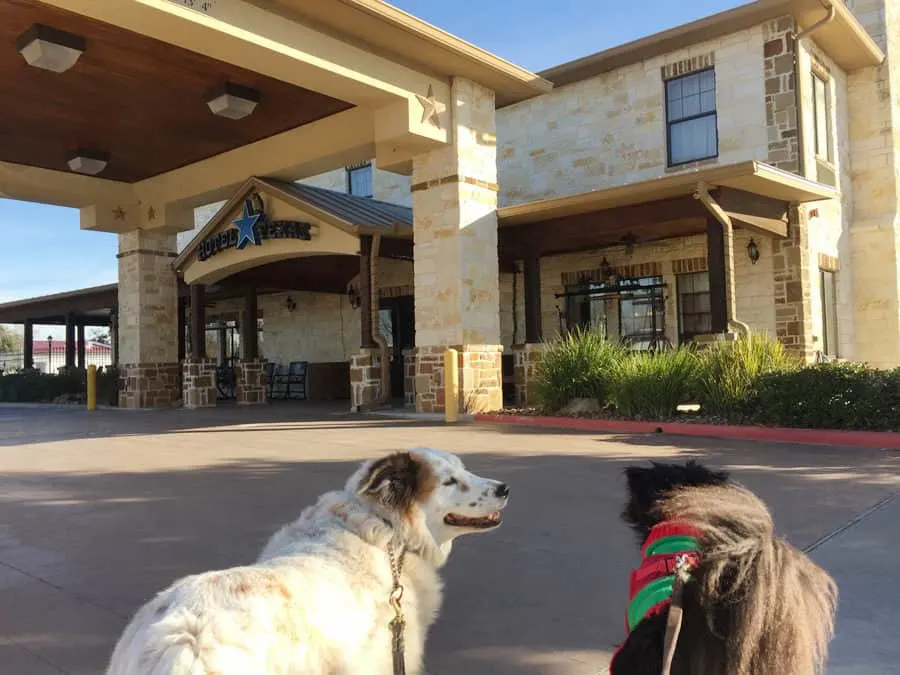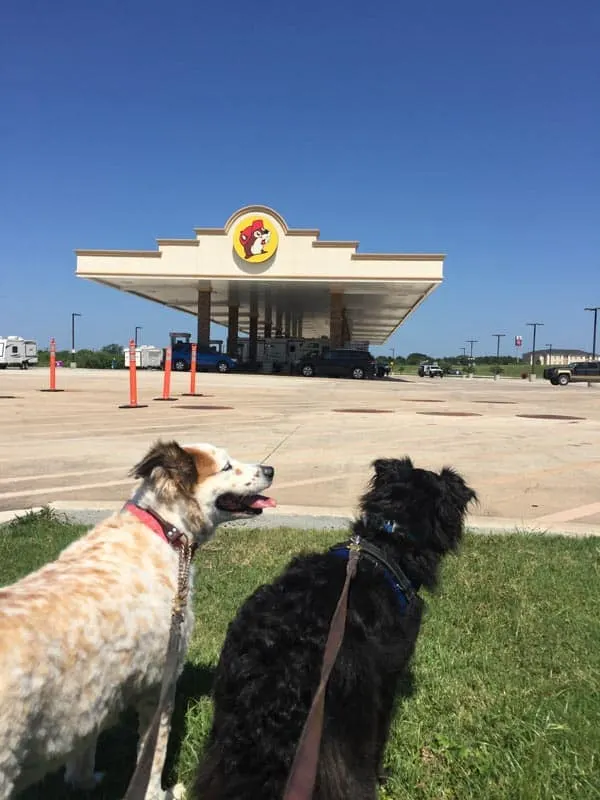Warmer weather means more than just a change of seasons: it means vacation! While vacation season once dictated boarding your pet, today more and more travelers opt to include their dogs in their getaway plans. Whether your dog vacation is a one-night getaway or an extended trip, we’ve got tips for making that first big trip a success for both you and your dog!

Whether you’ve recently adopted a puppy (or adult dog) or you’ve just never had the opportunity to travel with your dog in the past, your dog’s first vacation sets the stage for future travel—so you want the experience to be a good one for both the two- and four-legged travelers!
We love to travel with our dogs—but, whether we’re planning a day trip or a multi-day vacation, we always prepare and pack.
As with any good vacation, some pre-trip planning can make all the difference in making sure your dog has a tail-wagging time on his first vacation. Here are our tips for making your first dog vacation a success:
Ask Yourself If This Trip is Dog-Friendly

Before you make your trip plans, ask yourself if your dog would enjoy traveling with you. When planning a vacation with your dog, be sure to plan a trip that can be enjoyed by both you AND your dog together. (Never plan to leave your pet alone in the car while you make a quick stop; it’s a recipe for disaster.)
While a growing number of locations permit pets, many venues still don’t including most museums, fine dining establishments, theme parks, protected areas such as wildlife preserves and caverns, and more.
For most pet travelers, car travel is far easier than air travel. The exception would be small dogs under 20 pounds (and even smaller on some airlines) who will fit at your feet below the seat in front of you. If your dog does fly in the cabin of the airplane, he’ll need to remain in his kennel the entire flight; he cannot ride in your lap.
If your dog is too large to fly in the cabin, please consider driving instead of flying your pet.
Flying in the baggage compartment of an airplane is extremely difficult for pets (and many airlines do not fly dogs, especially brachycephalic dogs like bulldogs or pugs, during the summer months).
Ask Yourself If Your Dog is Ready to Travel
OK, your trip involves car travel, some fun outdoor activities, and plenty of time for making pit stops along the way—so far, so good!
Next, be honest with yourself about your dog’s behavior. Your dog should know basic commands and be socialized around new people before you take him to strange situations for an extended time.
Puppies should be fully vaccinated before hitting the road, especially for stops frequented by other dogs, like dog parks.
If you are still training your dog, you might want to make your first vacation a series of day trips, enjoying a trip to a new park, a dog-friendly patio restaurant, and a dog-friendly store before tackling an overnight vacation.
While your dog by no means needs to be a social butterfly to enjoy a getaway, you will want to be confident that he’ll be comfortable and safe as he meets new people and other dogs on the road.
Talk with a positive reinforcement dog trainer if you’re uncertain of how he’ll behave in new situations.
Start Slowly

Don’t make your dog’s first vacation a cross-country trip. Plan a short outing with your dog to a dog-friendly restaurant or a state park to see how you and your dog handle the experience.
Like what you see? Plan an overnight getaway (packing your dog’s favorite bedding, toy, and usual diet) to see how your dog handles the night in a new location.
Once you see that your dog will enjoy a night away, whether you’re choosing a campground, hotel, or bed and breakfast, it’s time to make trip plans!
Plan for Success

Step one is to plan a trip that’s going to be a success for your dog. Outdoor fun is often the easiest to plan with pooches. Generally most state parks (although not all beaches) welcome dogs on a leash no longer than six feet.
National parks are fairly restrictive, in many cases limiting dog access only to the areas you can reach by car.
Watch for Breed Restrictions
If your dog could be considered a “bully breed” – a broad term that includes dogs with blocky heads such as pit bull-looking dogs, Rottweilers, American Bulldogs, pit bull mixes and more—make sure your planned vacation area does not have breed restrictions that could endanger your dog.
Some destinations forbid dogs like pit bulls and traveling through those cities could put your dog at risk.
Do a search for your destinations (and destinations along your route) and the terms “breed restrictions” and “breed specific legislation” to make sure the destination is a fit for you and your dog.
If your dog could potentially be considered a bully breed, along with checking about potential restrictions at the destination, be sure to check on the hotel’s breed restrictions; sadly some hotels do not permit certain breeds.
Look for Pet-Welcoming Properties

Once you’ve pinpointed your destination, you’ll find that overnight stays are easier than ever thanks to the growing number of pet-friendly accommodations.
When comparing hotels, ask about both pet fees and pet deposits, making sure the deposit is actually a refundable one.
Also, check on weight restrictions at your potential hotel; some hotels limit guests to dogs under a particular weight.
Talk with Your Veterinarian
A pre-trip talk with your veterinarian is also a good idea to learn if there are any health considerations for your destination.
If you are planning a trip beyond your state’s borders, either by car or by plane, you’ll also want to obtain a Certificate of Veterinary Inspection or CVI.
Even if your trip will be close to home, you’ll want to ask for an extra copy of your dog’s vaccination records to take along in your car.
If your dog isn’t already microchipped, your veterinarian can chip your dog (a quick and easy process) and you can register the microchip number to identify your dog if he should become lost.
Plan on Flexibility
Traveling with your dog means slowing down and enjoying the journey. Be sure to plan for more frequent stops along the way—and build some flexibility into your itinerary.
Sometimes the smallest stops—like the roadside photo session in the field of wildflowers or the visit to a new dog park you discovered—can be the most memorable.

One of our dogs’ favorite stops is Buc-ee’s, a Texas-sized convenience store/gas station with a large designated dog potty area.
To our dogs, a potty stop there is like a trip to Disneyland; they get excited as soon as we pull into the parking lot.
Pack for Your Pooch

Just as in packing for your two-legged travel companions, pack special items for your dog’s comfort. (Here’s our dog travel packing list.)
A bed, even a special roll-up pet bed, can bring the scent and sense of security of home to a strange hotel room. A favorite toy is important as well, along with your dog’s usual diet and treats.

Pack collapsible bowls for food and water, and bring an extra leash and collar. Poop bags are a must; we also carry our YUCKY PUPPY® poop bag carrier for wagging that full poop bag on trail hikes and beach visits.
You’ll also want an ID tag with your name and your cell number; for an extra level of security, GPS trackers that attach to your dog’s collar can help you locate him using your smartphone. (We use Whistle GPS trackers on our dogs.)
Travel Safely

Wherever you may travel, be sure to take proper safety precautions. Just as you buckle all your human passengers in the car, it’s important both to your human and pet passengers that you safely restrain your dog in the car.
It only takes a minute to safely buckle your dog’s harness to the seat belts or to restrain him in a crate, carrier, or booster seat.
Not only will your dog be safer in the event of an accident or sudden stop, but you’ll be less distracted while you’re driving.
Once inside the car, make sure your dog’s head is kept inside the car to protect him from the risk of eye injury.
Crack the window to permit outside air and scents into the car but, for his safety, always keep your dog’s head inside the car where it belongs.
Your dog’s first vacation will fetch memories that you’ll enjoy for years to come—and will set the stage for many great trips to enjoy together. Vacationing with your dog is a great way to explore a destination, unleashing fun for both you and your dog!
More Dog Vacation Posts You Might Enjoy
Taking Your Dog on Your Disney Vacation
Helping Dogs on Your USVI Vacation
10 Vet Tips for Safe Summer Dog Travel
- Review: Jimmy BX7 Pro Anti-Mite Vacuum Cleaner - December 16, 2024
- 🎉 GIVEAWAY: Lord of the Pets Portrait of Your Dog! - November 26, 2024
- Review: Lord of the Pets Portraits - November 17, 2024
